

| Buprestidae - the Jewel Beetles of Nottinghamshire |
| .... |
| Generally elusive and difficult to find, to
the coleopterist, Jewel Beetles are the equivalent of extracting a
diamond from a coal face, or a gold nugget from the banks of the
River Trent. They are that elusive and no matter how long you try,
finding one can sometimes take far too long and it eventually becomes a
personal quest. But while the adults are difficult to come by, their larvae leave us some clues to their being present and these are much easier to find. Exit holes made by the larva prior to pupation after a living under bark, are particularly distinctive among all other exit holes being characteristically 'D' shaped. Jewel Beetles are known and named for their bright colours and in many instances are indeed, very aptly named. However the UK's Buprestidae are considerably more drab and dressed down and the more colourful species are found across Europe and in warmer countries. It has to be said that both the UK and Nottinghamshire aren't ideally placed to see the better examples the Buprestidae Family has to offer. |
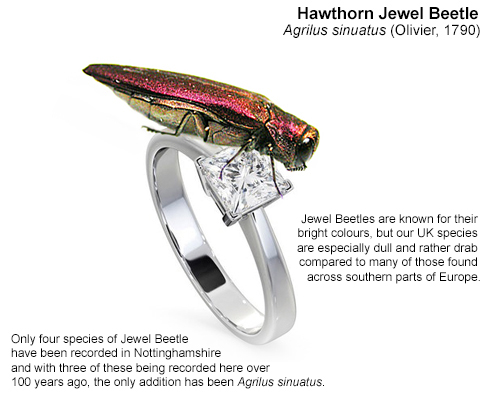 |
|
| .... | ||
|
There are 17 species on the UK list,
compared to over 200 across Europe, although the majority of these
are found in southern European countries. So if you want to see some
of the more colourful Buprestids, then perhaps consider moving
further south. Buprestidae in Nottinghamshire For those coleopterists and naturalists loyal to Robin Hood county, then the 17 UK species can be narrowed down to at least which have occurred, or been known to have occurred in Nottinghamshire. So its probably not such an exciting prospect now is it? But the overall elusiveness of the adult beetles alone, is enough of a challenge and there should be a few more species to add to the Nottinghamshire list over coming years. One of these newcomers (Agrilus cyanescens Ratzeburg, 1837) has already been recorded from Leicestershire and is breeding in neighbouring Lincolnshire. It makes realistic sense to suggest that it is already established on Honeysuckle growing in a Nottinghamshire woodland somewhere. |
||
| .... | ||
|
The lack of Buprestid records and
their general rarity in Nottinghamshire, was all too evident to
Victorian and Edwardian naturalists a century or more ago and they
would certainly have took pride of place in any collection. J.W. Carr provides records of just three species in his publication 'The Invertebrate Fauna of Nottinghamshire. Nottingham: J.& H. Bell Ltd (1916)' listing Agrilus biguttatus (Fabricius, 1777), Agrilus laticornis (Illiger, 1803) and Agrilus angustulus (Illiger, 1803). Since then, only Agrilus sinuatus (Olivier, 1790) found at Burton Joyce in 1998, has been added to the list and continues to be found on Hawthorn at an increasing number of sites across the county. Winter surveying and mapping The easiest way of finding any Jewel Beetle, is by looking for the characteristic 'D' shaped exit holes in the bark of trees. Searching on dead or dying trees can be done during the Winter months and is a straight forward process, as the holes are unmistakable. It also provides a quicker and easier way to map the distribution of each species across Nottinghamshire and for the coleopterist ... helps fill the days between Summers spent looking for the adults. |
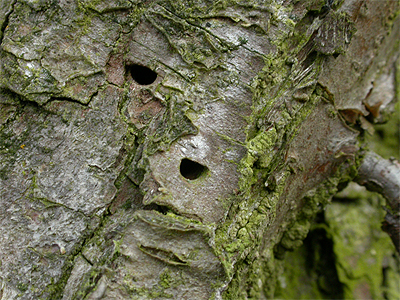 |
|
| .... | ||
|
Species accounts The following species accounts are based on the information and records currently available. |
||
|
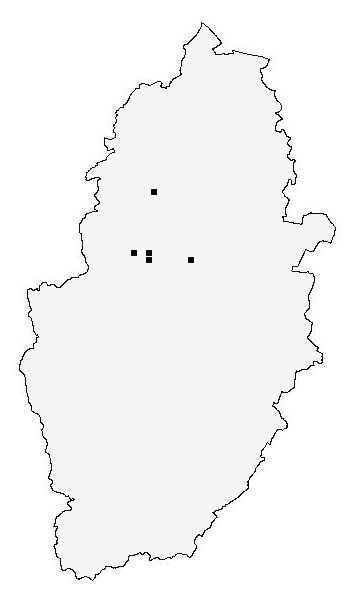 |
||||||||
| .... | |||||||||
| Those recent records we can list are from Sherwood Forest CP in
2010 (Dutton, A.), Sherwood
Forest CP on 05/06/10 and another on 07/06/10 and an astonishing
23 adults recorded from Wellow Park on 21/05/11
(Pendleton, T.A. & Pendleton,
D.T.).
Smaller and less colourful than Agrilus biguttatus, Agrilus angustulus has been less recorded of the Agrilus species found at Sherwood Forest NNR, but was recorded most recently in 2010 (Dutton, A.) Length of the ones we photographed were 6mm and 5mm. This beetle was present in good numbers (over 15 in a casual count) on Ash and Hazel regrowth in a clearing at Wellow Park at SK686672 in May 2011. There appear to have been no county records since. Hostplants: Oak Quercus robur, Beech Fagus sylvatica, Hornbeam Carpinus betulinus, Ash Fraxinus excelsior and Hazel Corylus avellana have all been recorded. |
|||||||||
|
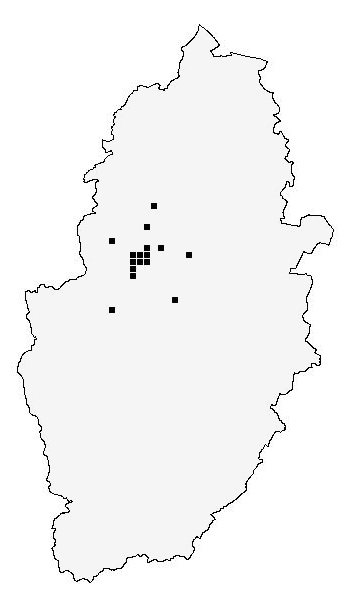 |
||||||||
| ...... | |||||||||
| Sherwood Forest remains the best place to find this beetle, but
evidence from recent records suggests that it is becoming
increasingly more widespread. The exit holes
have only
been recorded on a handful of Oaks within the country
park area and it is certainly under recorded, although obviously
increasing there. Away from Sherwood there is a 2021 record from
Eakring, where numerous exit holes were found on a recently dead Oak.
Exit holes (the easiest method of recording) were also found on
Strawberry Hill Heath near Mansfield in 2013. Hostplants: Various Oaks have been reported as hostplants, but Quercus robur is the tree usually affected at Sherwood Forest. There have also been claims of a possible link between Agrilus biguttatus and a number of very serious Oak diseases. If this was to ever prove to be the case, it would make the current practice of artificial distressing and forced creation of standing dead wood habitat occurring in Sherwood Forest, to be rather like playing with fire. |
|||||||||
|
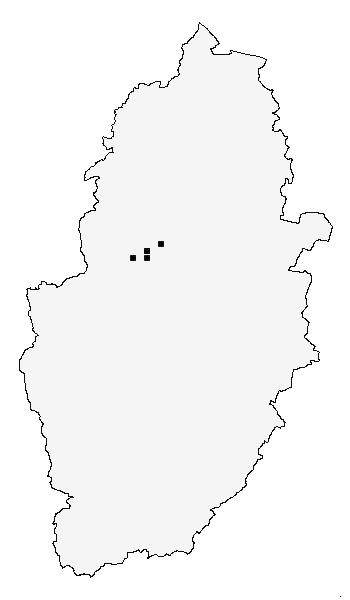 |
||||||||
| ...... | |||||||||
| Hostplants: Oak Quercus robur and Hazel Corylus avellana have been recorded. | |||||||||
|
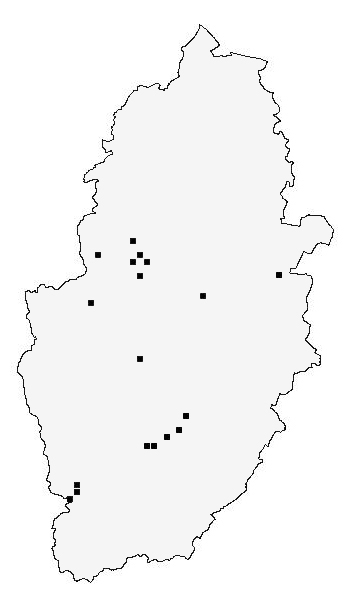 |
||||||||
| ...... | |||||||||
|
The spread of Agrilus sinuatus across Nottinghamshire has been
rapid and it is obviously a much under recorded species. It has been
found in some 16 1km grid squares, which include sites along the River
Trent at Burton Joyce, Stoke Bardolph, Hoveringham and Attenborough NR.
It was recorded new to the Sherwood Forest area by Keith Alexander, as
recently as 2009 and it is likely to be present anywhere there are
examples of old and dying Hawthorns. Other recorded sites are from Bath Lane at Mansfield, Oakmere Park at Oxton, Eakring Meadows NR and Hills and Holes SSSI at Market Warsop. Hostplants: Hawthorn Crataegus monogyna is the only reported hostplant. Exit holes are usually found on the lower branches, rather than the trunk. |
|||||||||
|
 |
||||||||
| Hostplants: Oak Quercus robur. | |||||||||
| Beetles |
| Homepage |